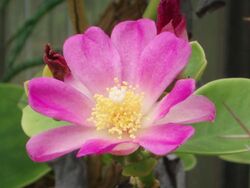Biology:Rhodocactus bahiensis
| Rhodocactus bahiensis | |
|---|---|

| |
| Scientific classification | |
| Kingdom: | Plantae |
| Clade: | Tracheophytes |
| Clade: | Angiosperms |
| Clade: | Eudicots |
| Order: | Caryophyllales |
| Family: | Cactaceae |
| Genus: | Rhodocactus |
| Species: | R. bahiensis
|
| Binomial name | |
| Rhodocactus bahiensis (Gürke) I.Asai & K.Miyata[2]
| |
| Synonyms[2] | |
| |
Rhodocactus bahiensis is a species of tree-like cactus that is endemic to the Brazilian state of Bahia. First described as Pereskia bahiensis, it was transferred to Rhodocactus in 2016. Like all species in the genus Rhodocactus, and unlike most cacti, it has persistent leaves. In its native locality, it is used to form hedges.
Description
Rhodocactus bahiensis grows as a small tree or a shrub, reaching 1–6 m (3–20 ft) high, with trunks to 30 cm (12 in) in diameter. The young twigs are green or reddish, and have a few stomata, mainly around the areoles. Mature stems develop grayish-brown bark. Like all species of Rhodocactus and unlike most other cacti, R. bahiensis has persistent leaves, the largest being up to 12 cm (4.7 in) long and 7 cm (2.8 in) wide. The leaves are succulent and have very short petioles, only 1–2 mm (0.0–0.1 in) long. The areoles bear leaves (brachyblast leaves) along with spines. The areoles on the twigs have up to six spines, those on the trunks may have about 45, each 2–6.5 cm (0.8–2.6 in) or exceptionally 9 cm (3.5 in) long. The pink to reddish-purple flowers are either solitary or borne in small terminal inflorescences of 2–12, and are 4–7 cm (1.6–2.8 in) across. The fruits are more-or-less pear-shaped, 3–6 cm (1.2–2.4 in) long, containing many glossy black seeds.[3]
In its native habitat, R. bahiensis flowers in the spring and summer, from October to April, and fruits in the autumn from March to June. It then loses its leaves in the winter dry season from about June to October.[3]
Taxonomy
The species was first described by R. L. M. Gürke in 1897 as Pereskia bahiensis.[4] Molecular phylogenetic studies suggested that when broadly circumscribed, Pereskia was not monophyletic, and consisted of three clades.[5][6] In 2016, the genus Rhodocactus was revived for one of these clades, which included R. bahiensis.[6]
Distribution and habitat
Rhodocactus bahiensis is endemic to the Brazilian state of Bahia,[2] where it is found in caatinga, subtropical dry shrubland.[1]
Conservation
Rhodocactus bahiensis has been assessed as Least Concern, with no major threats. It regenerates well after disturbance.[1]
Uses
Rhodocactus bahiensis is used locally for hedges. Cuttings are planted densely to form an impenetrable hedge, which is cut regularly.[3]
References
- ↑ Jump up to: 1.0 1.1 1.2 Taylor, N.P.; Zappi, D.; Machado, M.; Braun, P. (2020). "Pereskia bahiensis". IUCN Red List of Threatened Species 2020: e.T46510A183110063. doi:10.2305/IUCN.UK.2020-3.RLTS.T46510A183110063.en. https://www.iucnredlist.org/species/46510/183110063.
- ↑ Jump up to: 2.0 2.1 2.2 "Rhodocactus bahiensis (Gürke) Iss.Asai & K.Miyata", Plants of the World Online (Royal Botanic Gardens, Kew), https://powo.science.kew.org/taxon/urn:lsid:ipni.org:names:77154719-1, retrieved 2021-05-04
- ↑ Jump up to: 3.0 3.1 3.2 Leuenberger, Beat Ernst (1986), Pereskia (Cactaceae), Memoirs of the New York Botanical Garden, 14, Bronx, NY: New York Botanical Garden, ISBN 978-0-89327-307-1, http://mertzdigital.nybg.org/digital/collection/p9016coll16/id/6859/rec/2, retrieved 2021-05-02
- ↑ "Rhodocactus bahiensis (Gürke) Iss.Asai & K.Miyata", The International Plant Names Index, http://www.ipni.org/ipni/idPlantNameSearch.do?id=77154719-1, retrieved 2021-05-04
- ↑ Bárcenas, Rolando T.; Yesson, Chris; Hawkins, Julie A. (2011), "Molecular systematics of the Cactaceae", Cladistics 27 (5): 470–489, doi:10.1111/j.1096-0031.2011.00350.x
- ↑ Jump up to: 6.0 6.1 Asai, Issaku; Miyata, Kazunori (2016), "An Emendation of Rhodocactus, a Genus Segregated from Pereskia (Cactaceae)", Journal of Japanese Botany 91: 7–12, http://www.jjbotany.com/pdf/JJB_091_7_12.pdf, retrieved 2021-04-25
Wikidata ☰ {{{from}}} entry
 |


